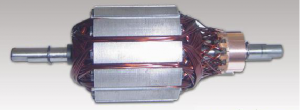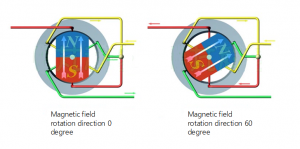Permanent magnetic synchronous motor is mainly composed of the stator, rotor, chassis, front-rear cover, bearings, etc. The structure of the stator is basically the same as that of ordinary asynchronous motors, and the main difference between the permanent magnet synchronous motor and other kinds of the motor is on its rotor.
The permanent magnet material with pre-magnetized (magnetic charged) magnetic on the surface or inside the permanent magnet of the motor, which provides the necessary air gap magnetic field for the motor. This rotor structure can effectively reduce the motor volume, reduce loss and improve efficiency.
The principle of a permanent magnet synchronous motor is as follows: In the motor’s stator winding into the three-phase current, after the pass-in current, it will form a rotating magnetic field for the motor’s stator winding. Because the rotor is installed with the permanent magnet, the permanent magnet’s magnetic pole is fixed, according to the principle of magnetic poles of the same phase attracting different repulsion, the rotating magnetic field generated in the stator will drive the rotor to rotate, The rotation speed of the rotor is equal to the speed of the rotating pole produced in the stator

Due to the use of permanent magnets to provide magnetic fields, the rotor process is mature, reliable, flexible in size, the design capacity can be as small as tens of watts, up to megawatts. At the same time, by increasing or decreasing the number of pairs of rotor permanent magnets, it is easier to change the number of poles of the motor, which makes the speed range of permanent magnet synchronous motors wider. With multi-pole permanent magnet rotors, the rated speed can be as low as a single digit, which is difficult to achieve by ordinary asynchronous motors. Especially in the low-speed high-power application environment, the permanent magnet synchronous motor can be directly driven by multi-pole design low speed, compared with ordinary motor plus reducer, the advantages of a permanent magnet synchronous motor can be highlighted.

The operation of the permanent magnet synchronous motor needs to be combined with the special drive system, the motor has good controllability, high control accuracy, continuously adjustable speed, large torque, small start-up current, high overload multiple, high efficiency, high power factor, and good energy-saving effect. Applications cover almost all areas of aerospace, defense, industry, agriculture, and daily life.
The magnetic field of the starting torque small and the large permanent magnetic synchronous motor has no relationship with the speed of the motor, unlike the three-phase induction motor must have rotor slip difference in order to produce torque. Therefore, the permanent magnet synchronous motor and DC motor can produce 2 to 3 times the torque of the plug torque at “0” speed. Therefore, it is particularly suitable for high use of anti-blocking requirements. A permanent magnet synchronous motor does not need to draw current from the power grid to produce the necessary magnetic field of the motor, so compared with an ordinary electric excitation motor, the permanent magnet synchronous motor is bound to be energy-efficient. For motors of different power levels, the savings of this part of excitation energy affect the efficiency of the motor is about 2% to 5%. The three-phase permanent magnet synchronous motor runs at synchronous speed (speed and frequency to maintain a fixed relationship), so when the three-phase permanent magnet synchronous motor is directly powered by the grid, its power factor is much higher than the three-phase induction motor. Generally can be close to 1.0, so can reduce the grid current amplitude of about 10% to 15%, power grid transmission loss reduced by 20% to 28%.
Low work temperature increase: When the asynchronous motor is working, the rotor winding has a flow of current, which is completely consumed in the form of heat, so a large amount of heat will be generated in the rotor winding, which increases the temperature of the motor, affecting the life of the motor. Due to the high efficiency of the permanent magnet motor, there is no resistance loss in the rotor winding, there is little or no reactive current in the stator winding, which makes the motor temperature rise low, and extends the life of the motor.